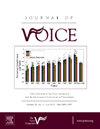在 COVID-19 大流行期间,虚拟教学对瑞典教师声音的影响。
IF 2.5
4区 医学
Q1 AUDIOLOGY & SPEECH-LANGUAGE PATHOLOGY
引用次数: 0
摘要
目的:自 2020 年初以来,由于 COVID-19 的流行,世界各地的教师不得不转为虚拟教学。这种教学模式的改变对教师的嗓音健康产生了未知的影响,因为教师的嗓音疾病发生率已接近普通人群的两倍。因此,本研究旨在调查虚拟教学与面对面教学相比,教师自我报告的嗓音问题,以及这些问题与工作环境中感知到的风险因素之间的关系:参与者包括 141 名瑞典高中和高等教育机构的教师(49 名男性,92 名女性),他们对一项基于互联网的调查做出了回应。调查使用嗓音障碍指数-10(VHI-10)的翻译版本,收集参与者自我报告的嗓音障碍信息。此外,还收集了两种教学模式(虚拟教学与面对面教学)下自我报告的 VTD(声带不适)症状和发音障碍的相关信息。调查还包括有关嗓音健康风险因素的问题:结果:自我报告的嗓音障碍和 VTD 症状在虚拟教学期间略低于面对面教学期间。与面对面教学相比,虚拟教学期间出现发音障碍症状的频率较低,但差异无统计学意义。此外,34% 的教师表示在面对面教学时遇到的嗓音问题更多,而 15%的教师表示在虚拟教学时遇到的嗓音问题更多。无论是虚拟教学还是面对面教学,报告最多的嗓音障碍症状都是喉咙发干和发紧。在两种教学模式中,报告频率最高的发音障碍症状是声音紧张和声音嘶哑。与虚拟教学中嗓音症状发生率较高和/或嗓音障碍程度较高相关的风险因素是空气质量和面对面教学时嗓音紧张。此外,虚拟教学中嗓音问题较多的教师也表示感觉压力较大:结果表明,与面对面教学相比,虚拟教学中的嗓音症状和嗓音障碍略有减少。尽管有多种因素,但结果表明,潜在的积极影响可能归因于工作环境中更好的空气质量和更有利的声学条件,从而避免了教师的嗓音紧张。本文章由计算机程序翻译,如有差异,请以英文原文为准。


Effects of Virtual Teaching on Swedish Teachers’ Voices During the COVID-19 Pandemic
Purpose
Since the beginning of 2020, teachers all over the world have had to switch over to virtual teaching because of the COVID-19 pandemic. This change of teaching mode has unknown consequences on the vocal health of teachers who already experience voice disorders at a rate nearly double that of the general population. Therefore, the purpose of this study is to investigate teachers’ self-reported voice problems during virtual teaching compared to face-to-face teaching and how they are associated to perceived risk factors in the work environment.
Method
Participants included 141 teachers (49 males, 92 females) in high schools and higher education in Sweden who responded to an internet-based survey. Information was collected about participants’ self-reported voice handicap using a translated version of the Voice Handicap Index-10 (VHI-10). Information about self-reported VTD (Vocal Tract Discomfort) symptoms and dysphonia was collected in regard to both modes of teaching (virtual vs face-to- face). The survey also included questions on risk factors related to vocal health.
Results
Self-reported voice handicap and VTD symptoms were slightly lower during periods of virtual teaching compared to periods of face-to-face teaching. There was a lower frequency of dysphonia symptoms during virtual teaching compared to face-to- face teaching, however the difference was not statistically significant. In addition, 34% of teachers reported experiencing more voice problems when teaching face-to-face while 15% reported more voice problems when teaching virtually. The most reported VTD symptoms during both virtual and face-to-face teaching were having a dry and a tight throat. The dysphonia symptoms with the highest reported frequency were a tense voice and hoarseness in both modes of teaching. Risk factors associated with higher prevalence of voice symptoms and/or higher levels of voice handicap during virtual teaching were air quality and straining the voice while teaching face-to-face. In addition, those teachers who reported more voice problems while teaching virtually also reported feeling more stressed.
Conclusion
The results showed a slight decrease in voice symptoms and voice handicap during virtual teaching compared to face-to-face teaching. Although multifactorial, results suggest that a potential positive effect may be attributed to better air quality in the work environment and more favorable acoustic conditions preventing teachers from straining their voice.
求助全文
通过发布文献求助,成功后即可免费获取论文全文。
去求助
来源期刊

Journal of Voice
医学-耳鼻喉科学
CiteScore
4.00
自引率
13.60%
发文量
395
审稿时长
59 days
期刊介绍:
The Journal of Voice is widely regarded as the world''s premiere journal for voice medicine and research. This peer-reviewed publication is listed in Index Medicus and is indexed by the Institute for Scientific Information. The journal contains articles written by experts throughout the world on all topics in voice sciences, voice medicine and surgery, and speech-language pathologists'' management of voice-related problems. The journal includes clinical articles, clinical research, and laboratory research. Members of the Foundation receive the journal as a benefit of membership.
 求助内容:
求助内容: 应助结果提醒方式:
应助结果提醒方式:


